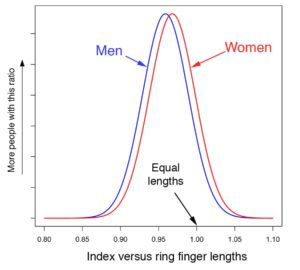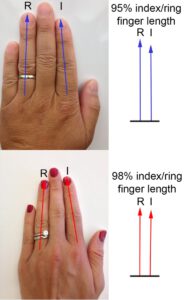Editor’s note: This post has been slightly edited since being posted in 2013.
By David Tran
Look at your hands. Is your ring finger longer than your index finger, or vice versa?
The length of a person’s index finger relative to his or her ring finger may tell us something about that individual’s exposure to sex hormones when he or she was still in the womb. But genetics also plays a big role here and recent studies are shedding light on the interplay between all these factors.

This graph shows the estimated distribution of people with different index to ring finger length ratios (X-axis). There’s a small but consistent pattern where women tend to have larger ratios.
While this may seem trivial, understanding how genetics and environmental factors influence finger length may give us insight into important biological functions.
Finger Length
It may help us understand not just bone development but also other seemingly unrelated traits and conditions. Recent studies show that people with autism tend to have a smaller index-to-ring finger ratio. In contrast, other studies have suggested associations between finger length ratio and prostate cancer, obesity, ADHD, and sexual orientation.
These findings are still preliminary; however, more research is needed.
Finger lengths have fascinated scientists for a long time.
Sex Differences
As early as 1875, researchers knew there was a difference between the sexes. For many women, the index finger is nearly the same length as the ring finger, while in men, the ring finger tends to be longer than the index finger.
On average, a woman’s index finger is about 97-98 percent the length of her ring finger, while a man’s index finger is about 96-97 percent. A ratio of 100 percent means your index finger is the same length as your ring finger.
Ratios
One thing to be aware of is that ratios can vary significantly between the left and right hands, so researchers often take the average of both hands.
These are not ironclad rules, so if your index to ring finger length ratio seems different from the average, don’t worry. Many people have a larger or smaller ratio. (See the accompanying graph for an estimation of the distribution of people with different finger ratios.)
You can see a lot of overlap between the sexes and changes in the ratios. Ratios change from person to person and may also be influenced by ancestry.
The Genetics of Finger Length

Two volunteers from 23andMe allowed us to measure their fingers and you can see in the picture that the man has a 95% ratio while the woman has a 98% ratio.
In 2013, a team led by John Mollon at Cambridge University in England reported that the single nucleotide polymorphism (SNP) was associated with a finger length ratio in people of European ancestry.
One genotype was associated with a 0.8 percent increase in finger length ratio. Another was associated with a 0.8 percent decrease in finger length ratio. The SNP lies near the SMOC1 gene, which is known to regulate bone growth and has been hypothesized to control finger length growth. Independent studies have suggested that the activity of the SMOC1 gene is controlled by testosterone and estrogen levels.
More Findings
In 2010, a study found that another SNP is associated with a 0.6 percent increase in finger length ratio. This SNP lies near the LIN28B gene, which is important for the development of the embryo and a key player in stem cell development. However, how sex hormones affect LIN28B is less clear.
Many researchers are interested in finger-length ratios because they may shed light on exposure to sex hormones in the womb. Some studies suggest that exposure to more estrogen than testosterone is linked to larger finger-length ratios, while more testosterone has the opposite effect, leading to smaller finger-length ratios.
Learn More
Find out if your genetics might Increase your risk for any health conditions with 23andMe.



